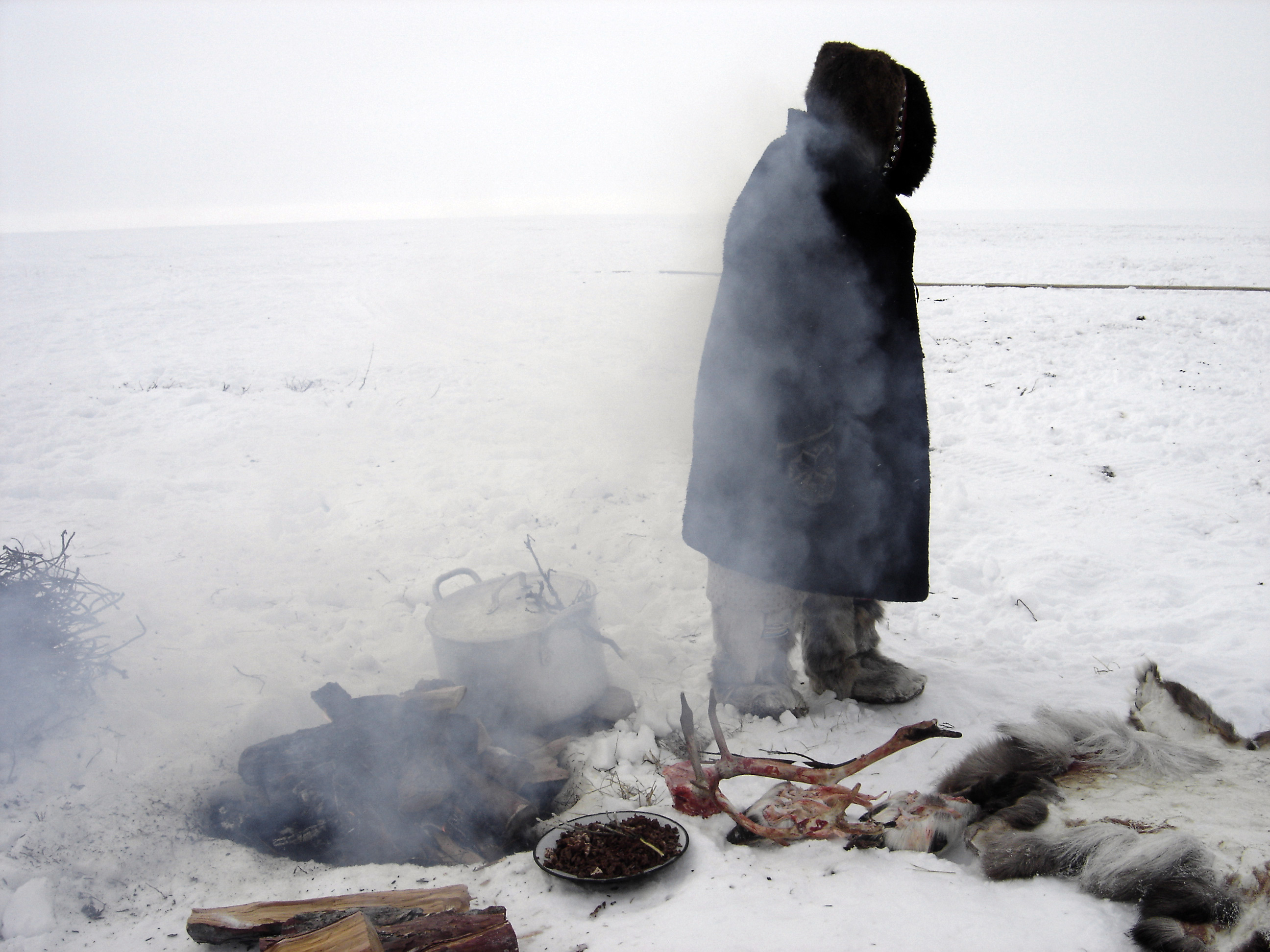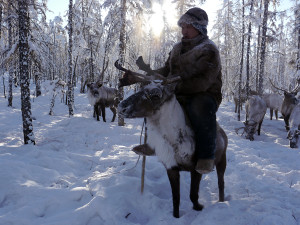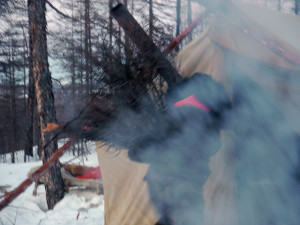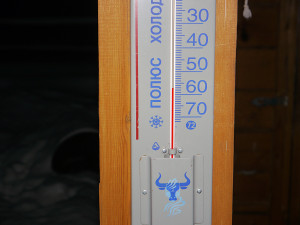The Evenki, formerly known as the Tungus, are spread over a huge territory (about 2,500,000 km²) of the Siberian taiga, or boreal forest, from the Orb River in the west to the Sea of Okhotsk in the east, and from the Arctic Ocean in the north to Manchuria and Sakhalin in the south. Having occupied this vast region since the Neolithic era, they are recognized as one of the indigenous peoples of the Russian North. with a population of more than 35,500. Anthropologically, the Evenki belong to the Baikal, a Paleo-Siberian Mongolian group.
The word “evenki” means “he who runs swifter than the reindeer.” Traditionally a mixture of pastoralists and hunter-gatherers, their informal economy is based on reindeer-herding, fishing, sable and fox trapping, hunting moose and wild reindeer, and in the south, cattle herding. Milk, derived from their cattle and reindeer herds, is the most highly prized commodity. In the past, most Evenki lived in conical tents, or chums, made from birch bark or reindeer hides tied to birch poles. Today, however, the national railway, hydroelectric and mining projects, and other industrial developments across the territory have radically influenced their traditional way of life. Most Evenki, including the families of the nomadic herders, are now settled in Russian villages and belong to collective or state farms.
Reindeer are used as pack and riding animals, since they are best suited to travelling over the boggy terrain of the tundra. The skill of riding the domesticated reindeer allowed the Evenki to colonize vast areas of the eastern taiga, which had previously been impenetrable. The Evenki use a saddle that is unique to their culture, which as placed on the shoulders of the reindeer, lessens the strain on the animal. Instead of stirrups, the Evenki use a stick to balance themselves.
Prior to contact with the Russians, the belief system of the Evenki was animistic. Their religious practices are of great historical interest because they retain some extremely archaic forms of belief. Among the most ancient ideas are spiritualization of all natural phenomena and personification of them, belief in upper, middle, and lower worlds, as well as belief in the soul (omi) and certain totemistic concepts. There were also various magical rituals associated with hunting and guarding herds, most of which were conducted by shamans. (The word “shaman” is an Evenki word, introduced to the Western world by the Russians.)
Like those from Yakutia, Evenki shamans were known to be exceptionally powerful. Traditionally, shamans either inherited their powers or were selected by the spirits. They identified metaphysically with all things, be they trees, rocks, water, fire or the animals that provided food, clothing and shelter. While in a trance, a shaman could journey into the upper world to persuade the game master to release the animals for the hunters. The spirits of deceased animals were pacified by the shaman to protect a hunter’s family from revenge.
Moose played a central role in Evenki rituals, and various rites performed before a moose hunt involved everyone in the group. The shaman would first walk into the forest, to the group’s sacred tree, to locate the female spirit that protected their lands and ask for her help in the hunt. She in turn would send the shaman to a zoomorphic spirit, which took the form of a giant cow moose. Through the help of this spirit, the shaman could picture himself lassoing the quarry, and that vision would help bring the animals closer to the hunters. If insufficient animals had been caught, the shaman would again visit the spirit woman and steal magical strands of wool from her that would turn into animals as soon as he returned to camp and shook them. Sometimes several reindeer were sacrificed and eaten so that they could be resurrected as moose.
Shamans were also quite skilled at mediating conflicts between humans and spirits. They protected people from enemies, evil spirits, illness, bad luck and starvation. Drums, chants, dances, sacrifice and specific rituals were their tools. These also acted as vehicles for communication with deceased ancestors, particularly at the moment of death.
Both men and women could be shamans, and many were also wise orators, humorous storytellers and singers. Younger shamans learned from their more experienced peers, and they studied the behavioral psychology of their group in order to better understand its social-historical fabric, which provided a strong knowledge base in order to make sound predictions.
Evenki shamans were shown respect by being given a place of honor, the best food, and access to the eldest member or family group for conversation. The group tended the shaman’s reindeer and always gave the shaman the best fishing place. Typically, a shaman was paid between one and four reindeer for each ritual.
While some rites, such as foretelling the future or looking for a lost reindeer, were performed in an ordinary chum, the more complicated rituals were conducted in a special shaman’s tent, which had strong connections with the lower, middle, and upper worlds through the hearth, a larch tree, and effigies. Symbolically, the hearth was seen as the beginning of life – the lower world – the home of the mistress of fire and rebirth. The larch was placed in the center of the tent, its roots in the hearth, and its branches extending through the top opening of the tent into the upper world. Shamans used the larch as a ladder to climb toward the upper world, while his or her spirit helpers rested on the tree’s branches. The welfare and fate of individuals, the group, and the shaman were connected with the larch. The shaman’s external animal soul and the souls of each group member resided in the tree. By hitting a drum that had a larch rim, the shaman allowed the animal soul to enter his or her body, and sent the spirit helpers to the underworld to check conditions before making the journey. This external soul was critical for the shaman’s journeys within the middle world – the world of the humans. It was said that: “If the tree dies, the shaman dies.”
The shaman’s tent was carefully protected from evil spirits and hostile shamans. Two wooden figurines, representing the shaman’s ancestor spirits, were placed at the tent’s entrance, and two large blocks of wood, symbolizing eels, were placed within sight of the tent to scare away or swallow harmful underworld spirits entering the middle world. Inside the shaman’s tent, wooden effigies of moose, reindeer, salmon and other spirit animals were placed in strategic locations to trap any evil spirits that managed to pass through the other protective barriers.
The Evenki believed that illness and death were spirits sent by another group’s shaman. Spirit helpers were called upon to swallow the disease spirit and carry it to the lower world, where it was released through the shaman’s intestinal tract. A barricade or fence of larch saplings placed around the ill person or around the entire camp served as further protection.
The clothing, mask, and drum of a shaman were sacred and could not be used by anyone else; otherwise the spirits would be unable to hear the shaman. Each Evenki shaman boot, made from closely cropped reindeer hide turned inside out, had a different purpose; on the right foot, the shaman wore “the boot of the sun,” and on the left was “the boot of the forest spirit monster.” Both were decorated with anthropomorphic, ancestral, and protective symbols to help shamans journey safely between worlds. The overall composition and placement of the decorations reinforced the rites performed by the shamans, and assisted in maintaining the necessary harmony among people, nature and spirits. Boots worn by shamans during healing ceremonies had glyphs symbolizing snakes, frogs and figure eights, all of which possess the power to receive and transfer life-giving fertility.
All such shamanistic rituals and beliefs help indigenous people to preserve their identity and their strong spiritual connection with the environment, natural phenomena such as animals, rivers, weather, stars and other elements of the universe, as well as with their ancestors whose guidance and advice were critical to their survival. For more than two hundred years, shamanistic activities were prohibited, first by the tsars and later by the Soviet regime. Sadly in those days, indigenous shamans were repressed or killed, their wares confiscated. However, despite this oppression, shamanism persisted in the more remote regions. Today, it is enjoying a revival and is once again being practiced openly.
Moki Kokoris is the Arctic Editor/Contributing Author to The Polar Times; The Explorers Journal; Indigenous Policy; and the World Ecology Report – Promoting Health and Environmental Literacy.





